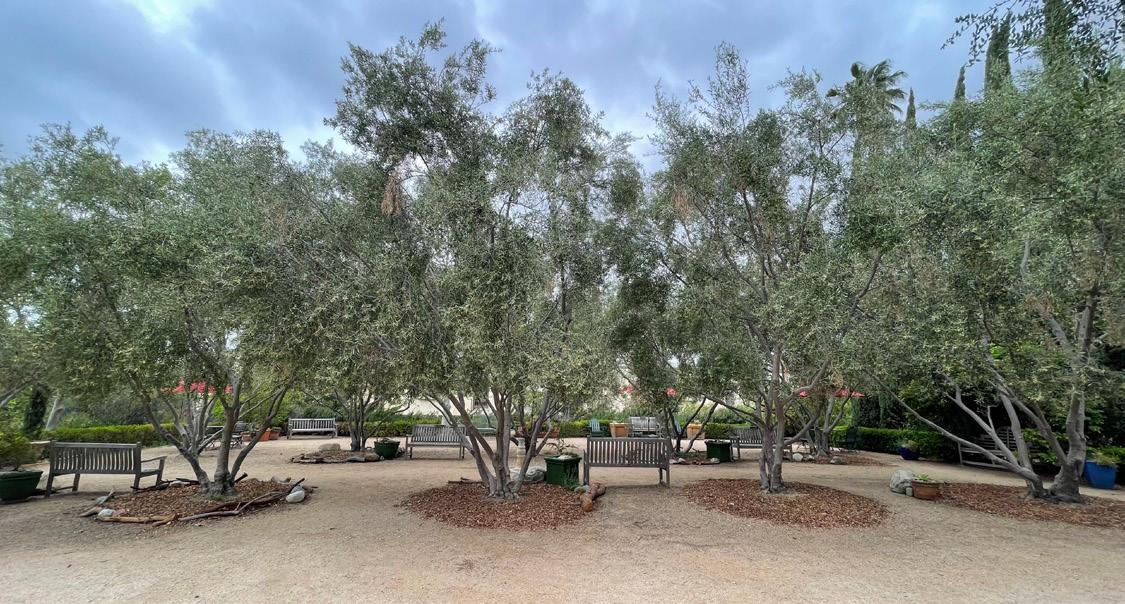
3 minute read
coulter pine
Mother Mountain Range
You can find Pinus coulteri in the San Gabriel Mountains north of Pasadena, where it joins with other conifers in fragrant bands wrapped around elevations up to 2100 meters. The San Gabriel Mountains are part of the Transverse Ranges, which are a confluence of smaller mountain ranges flowing east from the sea, eventually petering out in the dry deserts. They were created when a piece of the Earth’s crust rotated 90 degrees, distorted by the enormous, shearing energy of the Pacific tectonic plate scraping along the edge of North America. Activity at the edge of the North American plate elsewhere created volcanos — the Cascades that truckers pass along stretches of the 5
Advertisement
COULTER PINE: Pinus coulteri, big cone pine, widowmaker
ORIGIN: Coastal mountains in southern California Floristic Province extending up to San Francisco
MATURE HEIGHT AND WIDTH: 30-80 ft. high, trunk up to 3 ft. wide, canopy to 40 ft. wide
GARDENING NOTES: for larger yards or parks; grows in dry rocky soil in the mountains near the coast but away from the ocean.
Leucadenron Species
WERE FORGED in the astonishing species-factory of the western Cape of South Africa. They form an important part of fynbos — a woody shrub community similar to chaparral. Arlington features several species of this genus including Leucadendron discolor (also called “Piketberg conebush” and “rooi-tolbos” in Afrikaans) and cultivars such as “Jester” and “Safari Sunset.”
MUSEUMS, FIRE, AND BIODIVERSITY
Arlington Garden is a mediterranean climate garden with mild, wet winters and warm, dry summers. There are 5 mediterranean climate regions on the planet: California and parts of Baja California (together called the “California Floristic Province”), the Mediterranean Basin, the western Cape of South Africa, parts of southern Australia, and central Chile. In all of these regions except, historically, central Chile (which had few naturally-occurring fires), wet winters create growth, which burns over the dry period.
CONEBUSH SPECIES: Leucadendron sp. (“Safari Sunset” is pictured)
ORIGIN: Cape Floristic Province, South Africa
MATURE HEIGHT AND WIDTH: ranging in height and size, Leucadendron discolor is 6+ ft. tall and 5 ft. wide
GARDENING NOTES: requirements differ across species but Leucadendron discolor and many others require a full sun exposure with well-draining soil and limited summer water; many species of Leucadendron are susceptible to fungal disease when their roots are kept too wet or disturbed, hence, care should be taken when placing irrigation systems and weeding or planting in the root zone.
It is a general rule that an ecosystem’s biodiversity decreases the farther it is from the equator. All mediterranean climate regions are exceptions to this rule, however, because they are very biodiverse and far away from the lush, equatorial centre. Such regions cover approximately 2.2% of the globe yet are home to roughly 17% of all plant species. South Africa’s Cape Floristic Province has a particularly outsized impact on global plant diversity: although it is less than ⅓ the size of the California Floristic Province, it hosts twice the number of plant species with 70% found only there!
Why do these fluctuating, dusty spots along the edge of continents have such a rich diversity of species? Robert Cowling, Philip Rundel, and others have argued that there is no single explanation. In South Africa and Australia, historically stable geological and climatic conditions reduced extinctions, contributing to diversity. Such places are sometimes called “museums.” In California and the
Mediterranean Basin, the existence of many geological, climate, and soil types also contributed to diversity.
A 2018 paper by Philip Rundel and others argues that predictable, frequent fires are a contributing factor to species richness in all mediterranean regions except central Chile. Over blind stretches of evolutionary time, some plant families in these regions diversified to create new, more fire-adapted lineages. These lineages evolved to store more water in their limbs and trunks, thicken bark, and resprout and germinate in response to heat and smoke.
In fynbos, the cyclic churn caused by fire may also allow for the coexistence of similar species with no group able to dominate before the ecosystem burns again. Fire creates predictable flux, and flux can lead to diversity.
Conebush Is A Strategic Perisher
Some fire-adapted species, such as coast live oak in California, survive fires. Survivors have thick bark that resists flames or resprout from burls or roots. Leucadendron discolor on the other hand, is a strategic perisher. This conebush dies in fire, but it has evolved a cone that survives and opens in response to the blaze (the term for this is “serotiny”). Following fire, the cone reseeds without competition from adult plants.










